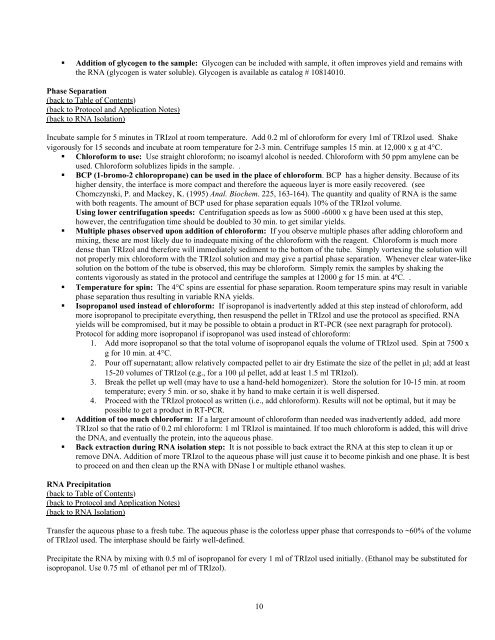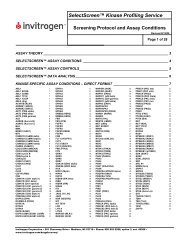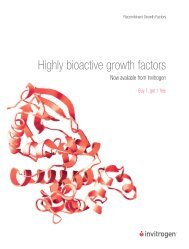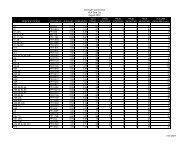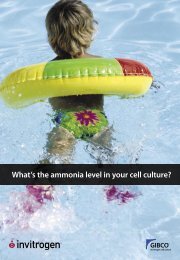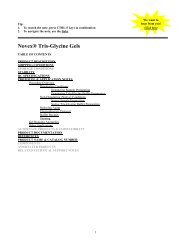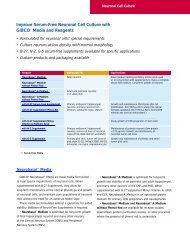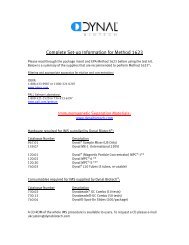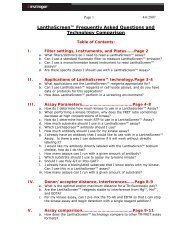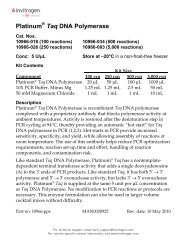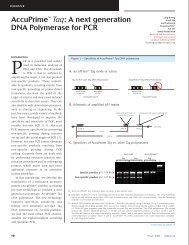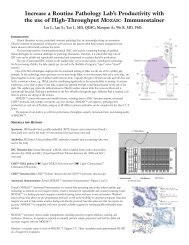TRIzol Reagent - Invitrogen
TRIzol Reagent - Invitrogen
TRIzol Reagent - Invitrogen
You also want an ePaper? Increase the reach of your titles
YUMPU automatically turns print PDFs into web optimized ePapers that Google loves.
Addition of glycogen to the sample: Glycogen can be included with sample, it often improves yield and remains with<br />
the RNA (glycogen is water soluble). Glycogen is available as catalog # 10814010.<br />
Phase Separation<br />
(back to Table of Contents)<br />
(back to Protocol and Application Notes)<br />
(back to RNA Isolation)<br />
Incubate sample for 5 minutes in <strong>TRIzol</strong> at room temperature. Add 0.2 ml of chloroform for every 1ml of <strong>TRIzol</strong> used. Shake<br />
vigorously for 15 seconds and incubate at room temperature for 2-3 min. Centrifuge samples 15 min. at 12,000 x g at 4°C.<br />
Chloroform to use: Use straight chloroform; no isoamyl alcohol is needed. Chloroform with 50 ppm amylene can be<br />
used. Chloroform solublizes lipids in the sample. .<br />
BCP (1-bromo-2 chloropropane) can be used in the place of chloroform. BCP has a higher density. Because of its<br />
higher density, the interface is more compact and therefore the aqueous layer is more easily recovered. (see<br />
Chomczynski, P. and Mackey, K. (1995) Anal. Biochem. 225, 163-164). The quantity and quality of RNA is the same<br />
with both reagents. The amount of BCP used for phase separation equals 10% of the <strong>TRIzol</strong> volume.<br />
Using lower centrifugation speeds: Centrifugation speeds as low as 5000 -6000 x g have been used at this step,<br />
however, the centrifugation time should be doubled to 30 min. to get similar yields.<br />
Multiple phases observed upon addition of chloroform: If you observe multiple phases after adding chloroform and<br />
mixing, these are most likely due to inadequate mixing of the chloroform with the reagent. Chloroform is much more<br />
dense than <strong>TRIzol</strong> and therefore will immediately sediment to the bottom of the tube. Simply vortexing the solution will<br />
not properly mix chloroform with the <strong>TRIzol</strong> solution and may give a partial phase separation. Whenever clear water-like<br />
solution on the bottom of the tube is observed, this may be chloroform. Simply remix the samples by shaking the<br />
contents vigorously as stated in the protocol and centrifuge the samples at 12000 g for 15 min. at 4ºC. .<br />
Temperature for spin: The 4°C spins are essential for phase separation. Room temperature spins may result in variable<br />
phase separation thus resulting in variable RNA yields.<br />
Isopropanol used instead of chloroform: If isopropanol is inadvertently added at this step instead of chloroform, add<br />
more isopropanol to precipitate everything, then resuspend the pellet in <strong>TRIzol</strong> and use the protocol as specified. RNA<br />
yields will be compromised, but it may be possible to obtain a product in RT-PCR (see next paragraph for protocol).<br />
Protocol for adding more isopropanol if isopropanol was used instead of chloroform:<br />
1. Add more isopropanol so that the total volume of isopropanol equals the volume of <strong>TRIzol</strong> used. Spin at 7500 x<br />
g for 10 min. at 4°C.<br />
2. Pour off supernatant; allow relatively compacted pellet to air dry Estimate the size of the pellet in µl; add at least<br />
15-20 volumes of <strong>TRIzol</strong> (e.g., for a 100 µl pellet, add at least 1.5 ml <strong>TRIzol</strong>).<br />
3. Break the pellet up well (may have to use a hand-held homogenizer). Store the solution for 10-15 min. at room<br />
temperature; every 5 min. or so, shake it by hand to make certain it is well dispersed.<br />
4. Proceed with the <strong>TRIzol</strong> protocol as written (i.e., add chloroform). Results will not be optimal, but it may be<br />
possible to get a product in RT-PCR.<br />
Addition of too much chloroform: If a larger amount of chloroform than needed was inadvertently added, add more<br />
<strong>TRIzol</strong> so that the ratio of 0.2 ml chloroform: 1 ml <strong>TRIzol</strong> is maintained. If too much chloroform is added, this will drive<br />
the DNA, and eventually the protein, into the aqueous phase.<br />
Back extraction during RNA isolation step: It is not possible to back extract the RNA at this step to clean it up or<br />
remove DNA. Addition of more <strong>TRIzol</strong> to the aqueous phase will just cause it to become pinkish and one phase. It is best<br />
to proceed on and then clean up the RNA with DNase I or multiple ethanol washes.<br />
RNA Precipitation<br />
(back to Table of Contents)<br />
(back to Protocol and Application Notes)<br />
(back to RNA Isolation)<br />
Transfer the aqueous phase to a fresh tube. The aqueous phase is the colorless upper phase that corresponds to ~60% of the volume<br />
of <strong>TRIzol</strong> used. The interphase should be fairly well-defined.<br />
Precipitate the RNA by mixing with 0.5 ml of isopropanol for every 1 ml of <strong>TRIzol</strong> used initially. (Ethanol may be substituted for<br />
isopropanol. Use 0.75 ml of ethanol per ml of <strong>TRIzol</strong>).<br />
10


